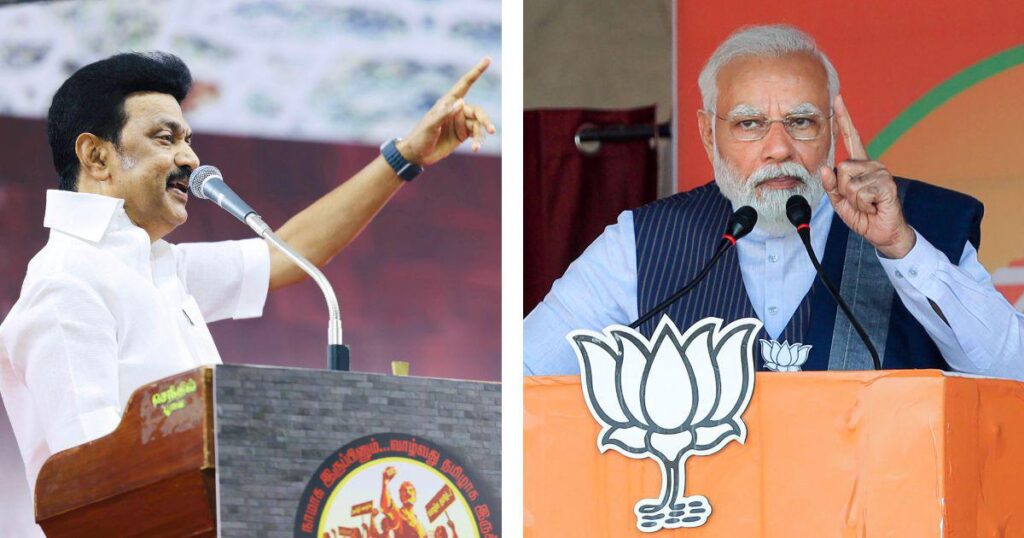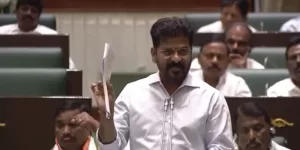In June, the Reserve Bank of India in its bulletin issued a warning over the deteriorating fiscal condition of state governments due to rising expenditure on “freebies”, or government sops.
In August, the Supreme Court observed that the “promise of irrational freebies is a serious issue” and asked the Union government to constitute a panel to study the matter. In subsequent meetings, Prime Minister Narendra Modi alleged that “taxpayers resent their hard-earned money being splurged away on freebies”.
An intense debate on “freebies” ensued. One side argued that freebies are an economic burden on the state’s coffers and that they reduce productivity by making people “lazy”. The other side defended government sops as a form of targeted welfare schemes with future social and economic gains and said these should not be termed “freebies”.
This debate also represents the clash between the Hindutva and Dravidian development models of the Indian welfare state.
The Hindutva model of development is characterised by the citizen’s duty to the nation’s development as their highest moral. On the other hand, the Dravidian model is defined by the state’s obligation to create citizen-centric development through a rights-based welfare approach.
The “freebie” debate raises questions about the kind of developmental model adopted by the state for the welfare of its people. Relatedly, the type of relationship that must exist between the state and its people.
These two developmental models are based on two different conceptions of the self and political authority. In modern terms, they are state-society relationships that political scientist Rajeev Bhargava defines as active and passive citizenship. The passive subject compromises democracy by making citizenship redundant.
The ideas underlying the active citizen and passive subject can be traced back to the Bhakti and Siddhar ideologies of medieval Tamil Nadu.
The Bhakti ideology is defined by self-surrender and personal loyalty and correlates with passive citizenship. Egalitarianism is at the heart of the Siddhar movement and correlates with active citizenship. These ideologies have shaped different strands within Tamil nationalism and politics in independent India.
In recent times, they underlie the Hindutva and Dravidian models of development, as can be seen in the freebies debate. National belonging for the poor and elite takes different forms in these models: one could be of positive engagement with the national society, and the other of resigned presence.
Two ways of being an Indian
In modern nation-states, citizens are bestowed with rights and duties, which enable sets of freedom and responsibilities. Bhargava interprets citizenship in terms of “active and passive”. Active citizens utilise their bestowed rights to develop the “self” by actively discussing, criticising, and using legally available means to influence public policy and law.
In contrast, passive citizens (in)voluntarily surrender their rights and disengage from public issues. They are closer to being political subjects. As political subjects, passive citizens live by the grace of the ruler and receive protection and other benefits in lieu of loyalty. When a subject receives a small, negligible portion of the state’s treasury, they believe it is charity flowing directly from the ruler’s generosity.
The subjects repay the munificence of the ruler by performing their devoted duties and loyalty. In short, passive citizenship is the return of medieval-era political subjugation in which democracy is compromised and citizenship becomes redundant.
Tamil nationalism, modern citizenship
The ancient indigenous philosophies exist as a “primordial sentiment” among the masses – what anthropologist Clifford Greetz describes as a strong feeling toward one’s language, kinship, territory or religion. Further, these sentiments resonate with the modern concept of active citizenship and passive subject and mark their presence in the contemporary Indian polity.
The developmental debate between the Hindutva and Dravidian models can be correlated with the philosophical discourse on the religious ideologies of Bhakti and Siddhar. With its dualistic transcendence philosophy, Bhakti propounds the “surrender of the self”. Antithetically, Siddhar and its non-dualistic immanence philosophy – manifested in the material world – advocate the “emancipation of the self”.
Bhakti as an ideology has far-reaching social functions apart from religion. Bhakti reflects the feudal order based on personal loyalty, which forms the foundation of the social relations built around production activities.
The medieval social formation based on the Brahmanical social hierarchies along devotional bhakti led to the growth of composite social ties in which state and religion became integral. Mutual beneficial relations emerged among the elites composed of the Brahmins, rulers, and dominant landlords.
This reflects in the Hindutva developmental model as well, where elite corporates are given tax sops and loan waivers. But, the money spent on the qualitative development of the poor in terms of health, education, and living standards is questioned and termed “backwards”.
The Siddhar philosophical discourse, as an ideological alternative to bhakti, emphasises the true nature of human existence. Most Siddhars belonged to low castes. Their radical ideologies emerged from their first-hand experience of oppression. They displayed dissension against all forms of oppression, reverberating with the people’s discontentment. Their main objective was to awaken those forced to accept their subordinated societal position.
Siddhar’s ideology influenced Dravidian populism and designed their vision for development on the lines of “emancipation of the self”. The Dravidian model of development based on the redistribution of resources through affirmative actions clubbed with targeted welfare measures has raised people’s living standards and instilled dignity in them.
In medieval times, Bhakti Brahmanism served as a politico-religious ideological tool for the subjugation of the masses. As an ideology, bhakti provided the psychological basis for the social acceptance of exploitation by emphasising voluntary enslavement to a particular deity or god. The hegemony of rulers had a proportional relation with the bhakti ideology. The rulers were treated at par with deities or gods.
As Bhakti spread deeper among the masses, the power of the ruling elites became more stable. It facilitated the state authority’s execution without deploying coercive forces. In contemporary times, Hindutva has reduced citizens to passive political subjects where people devote themselves to the leader’s ascribed duties towards the nation’s development.
National belonging for the poor
To conclude, religion plays a Janus-headed role in societies across the world by oscillating between the bipolarities of “strangulation” and “liberation”. By strengthening and reinforcing doctrines preaching blind devotion, religious fundamentalism in the hands of elites acts as an ideology of subjugation by, at times, providing dubious moral justification for acts of violence committed in the name of religion.
On the contrary, true spiritualism, as a voice of dissent and resistance against elites, inculcates humanism and egalitarianism among people. The same is reflected in the words of C.N. Annadurai, Dravidian ideologue and architect of the rights-based welfare approach in Tamil Nadu:
“I have drawn the conclusion which I felt was reasonable that reliance on too many gods and rituals was not necessary for faith in God. I said true faith in God is to have faith in fellow human beings… Of course, I am a rationalist who wants to end unreason and blind faith in the people. But genuine belief and true faith in God should be there amongst the people so that it helps them to become more and more aware and conscious of their duties and responsibilities to their fellow human beings.”
Against this backdrop, with the developmental slogan “It is in the smile of the poor, we see God”, the rights-based welfare approach of the Dravidian parties has put Tamil Nadu’s socio-economic indicators on a higher growth trajectory.
The Dravidian developmental approach embodying “active citizenship” has instilled national belongingness among the poor by designing a structure where the needs or rights of the people meet by the policies or duties of the state.
(Lipika Ravichandran is a PhD candidate at Jawaharlal Nehru University, New Delhi. Courtesy: Scroll.in.)




